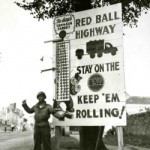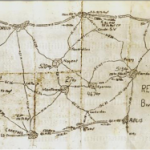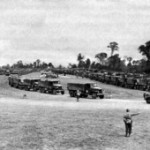Red Ball Express Created
- An MP directs Red Ball Express drivers to
stay on the ‘Ball.’ September 5th, 1944
Gift of Julian Dean, 2010.523.350
- Hand drawn map showing one of the original
Red Ball Express routes around Chartres, France
- Massive Red Ball Express convoys passing
through a regulating point
70 years ago today, within an environment of institutional prejudices and against a stubborn German foe, the most famous American service unit of World War II – the Red Ball Express – was born. Throughout most of the War, the predominant assignments given to African-American servicemen was within the Quartermaster and Transportation Corps. Nevertheless, although many African-American soldiers found themselves segregated from white units and relegated to non-combat roles,this did not keep them, or the over 75% African American drivers of the Red Ball Express, out of the fight.
The Red Ball Express – its name taken from a railroad term meaning express freight – was a massive, round-the-clock convoy of supply-trucks, organized in north-western France as an immediate response to the problem of keeping the forward-area elements of the American First and Third Army supplied with petroleum, oil and lubricants (also known as POL supplies). Following the late July 1944 break-out in Normandy, American forces found themselves outpacing the reach of their supply lines. In an effort to solve this crisis – described by war correspondent Ernie Pyle as “a tactician’s hell and a quartermaster’s purgatory” – and bridge the gap between the soldiers at the front and the supply dumps at the Normandy beach-heads, the Red Ball Express was born.
On August 25, 1944, the Red Ball Express highway – two long-distance, one-way ‘loop highway’ routes – was opened at the port town of Cherbourg. Similar to the human circulatory system, the Red Ball highway’s northern route was for delivering supplies and the southern route was for returning convoys, with both routes open only to military traffic. A shortage of trucks and drivers for the Red Ball Express routes saw any non-essential vehicles pressed into service and many ‘volunteers’ – some of whom had never driven any type of automobile before – thrown behind the wheel and transformed overnight into drivers. One Red Ball recruit recalled that ‘Red Ball trucks broke, but they didn’t brake.’ On average, over 900 ‘deuce-and-a-half’ trucks were rolling on the Red Ball Highway at any one time, carrying thousands of tons of supplies forward, fueling the American advance.
Though only in existence for three months, from between August 25th and November 16th, 1944, the importance of the Red Ball Express and the heroic efforts of its drivers was clearly understood by Allied leadership in this, the world’s first “100 percent internal combustion engine war.” Over the course of 83 days, the Red Ball Express and its drivers delivered over 500,000 tons of supplies vital to the American war effort and the liberation of Europe. The Red Ball Express also served as indisputable proof of the quality of African-American soldiers. In an October, 1944 message to the troops, General Eisenhower was not at all faint in his praise for the Red Ball Express’ drivers.
October 1944
TO: The Officers and Men of the Red Ball Highway
1. In any war, there are two tremendous tasks. That of the combat troops is to fight the enemy. That of the supply troops is to furnish all the material to insure victory. The faster and farther the combat troops advance against the foe, the greater becomes the battle of supply.
2. Supplies are reaching the continent in increasing streams. But the battle to get those supplies to the front becomes daily of mounting importance.
3. The Red Ball Line is the lifeline between combat and supply. To it falls the tremendous task of getting vital supplies from ports and depots to the combat troops, when and where such supplies are needed, material without which the armies might fail.
4. To you drivers and mechanics and your officers, who keep the Red Ball vehicles constantly moving, I wish to express my deep appreciation. You are doing an excellent job.
5. But the struggle is not yet won. So the Red Ball Line must continue the battle it is waging so well, with the knowledge that each truckload which goes through to the combat forces cannot help but bring victory closer.
DWIGHT D. EISENHOWER
General, U. S. Army
The National WWII Museum echoes the words of General Eisenhower and honors the contributions of the brave men of the Red Ball Express and all African-Americans in World War II. The National WWII Museum’s Red Ball Express mobile outreach program, which today ‘delivers’ hands-on programming about World War II history to New Orleans region schools, takes its name in their honor.
This post by Collin Makamson, Family Programs & Outreach Coordinator @ The National WWII Museum
- Posted :
- Post Category :
- Tags : Tags: African Americans in WWII
- Follow responses to this entry through the RSS 2.0 feed. You can skip to the end and leave a response. Pinging is currently not allowed.







Leave a Reply